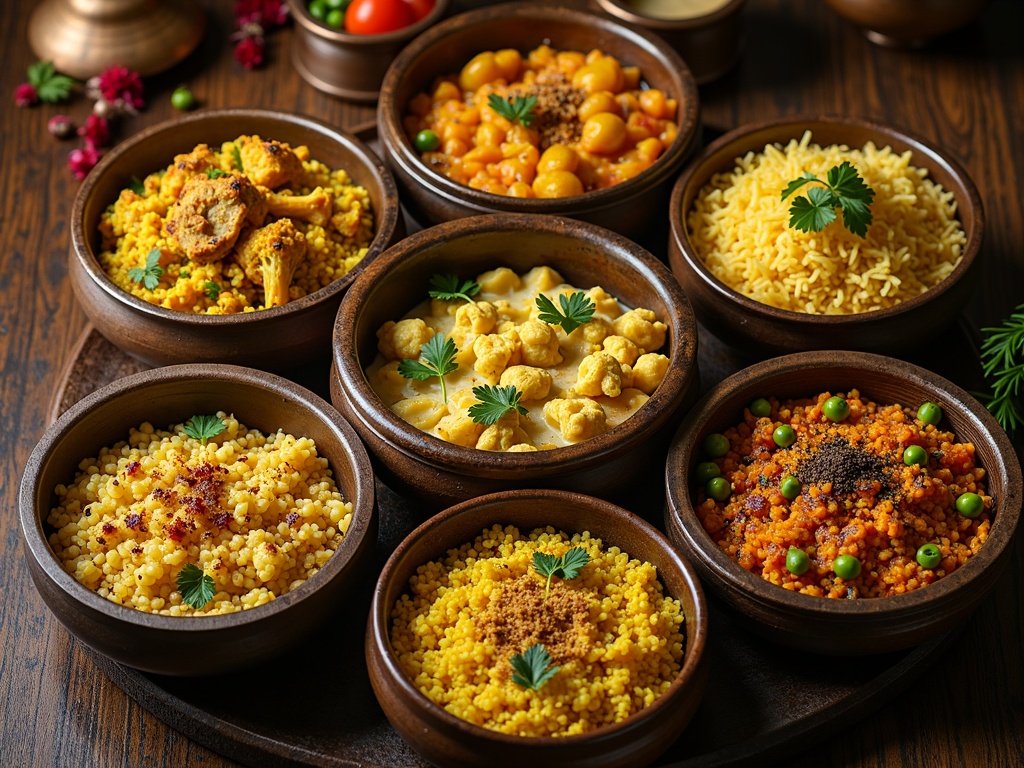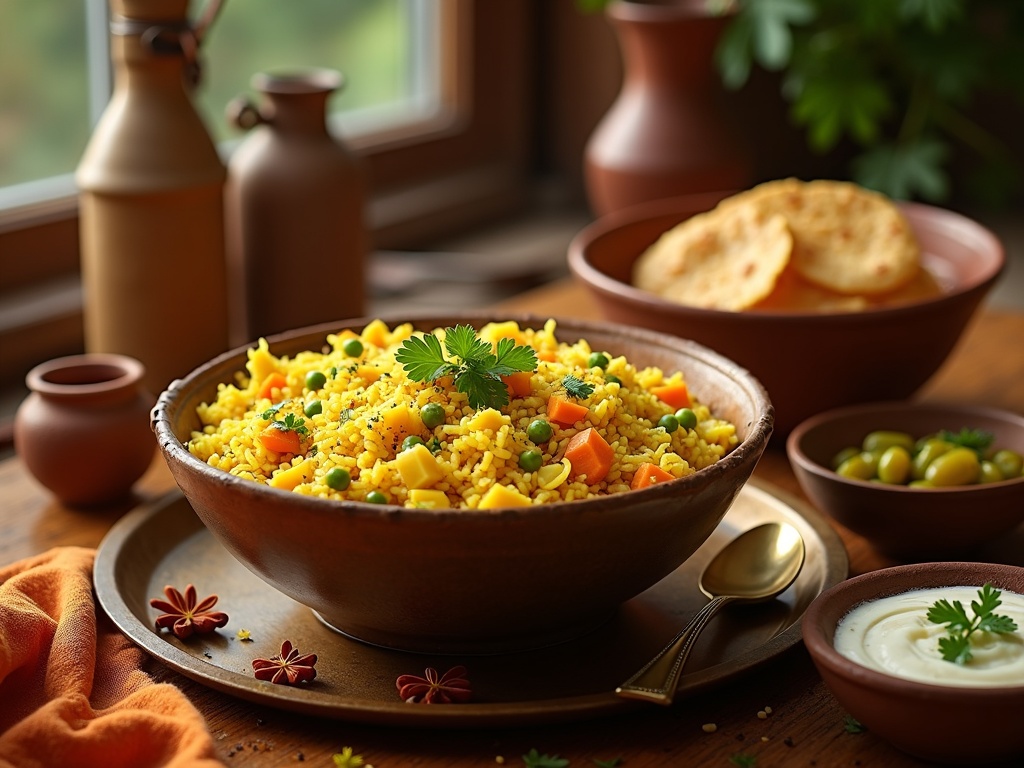Khichdi: A Nutritious and Comforting One-Pot Meal
Khichdi stands out as a versatile one-pot dish that blends rice and lentils, offering both comfort and healing nutrition throughout India.
I appreciate its gentle digestibility and complete protein profile, which makes it suitable for everyone from babies to seniors. Each region adds its own twist, creating unique flavors and cultural significance.
Table of Contents
Key Takeaways
- Khichdi balances all three Ayurvedic doshas (Vata, Pitta, and Kapha) and is renowned for its exceptional digestibility, making it perfect for recovery periods and detox days.
- The combination of rice and lentils creates a complete protein profile while requiring minimal effort from the digestive system.
- Traditional preparation involves tempering spices in ghee, with regional variations ranging from Bengali festival versions to Gujarati kadhi pairings.
- Common mistakes include incorrect rice-to-lentil ratios, skipping the tempering process, and achieving an improper consistency.
- Khichdi is highly adaptable to dietary needs and can be customized with seasonal vegetables, making it both economical and nutritionally dynamic.
For those interested in more traditional recipes and cultural significance of Indian dishes, the dish has even been celebrated as a symbol of unity at events like the World Food India summit, where it was promoted as India’s national dish.
What Makes Khichdi So Special
Khichdi stands out as a remarkable one-pot dish combining rice and lentils that has nourished generations across India. This humble meal carries significant healing properties that make it more than just everyday food. I’ve found that khichdi’s gentle nature makes it perfect for anyone needing a break from heavy meals while still craving something satisfying.
The Perfect Healing Food
Khichdi’s gentle yet nourishing qualities stem from its simple ingredients and cooking process. The combination of rice and lentils creates a complete protein profile, similar to what you might find in more complex chicken biryani recipes but in a much lighter form. What makes this dish truly special is its role in Ayurvedic tradition as a healing food that balances all three doshas—Vata, Pitta, and Kapha.
The magic of khichdi lies in its exceptional digestibility. When rice and lentils cook together, they break down in a way that requires minimal effort from your digestive system. This makes it perfect for:
- Recovery periods after illness
- Detox days when your body needs a reset
- Soothing upset stomachs or digestive issues
- Baby’s first solid food introduction
- Elderly nutrition when digestion becomes challenging
Unlike richer Indian dishes such as butter chicken, it provides complete nutrition without taxing your system. The dish stands as a testament to the wisdom embedded in traditional Indian cooking methods.
What fascinates me about khichdi is how it transforms across India’s diverse regions while maintaining its core healing benefits. In Bengal, you’ll find it with a splash of ghee and fried spices, while Gujarat offers a sweeter variation with jaggery. Some regions pair it with soft chapatis for a complete meal.
The versatility of khichdi extends beyond regional variations—it adapts to whatever vegetables are seasonally available. This practical approach to cooking makes khichdi both economical and nutritionally dynamic, offering different vitamin profiles depending on what’s added to the basic recipe.
When feeling under the weather, I turn to this dish for its gentle healing properties—something you won’t find in more complex treats like gulab jamun or savory snacks. The beauty of khichdi is that it nurtures without overwhelming, satisfies without stressing your system, and heals while still delighting your taste buds.
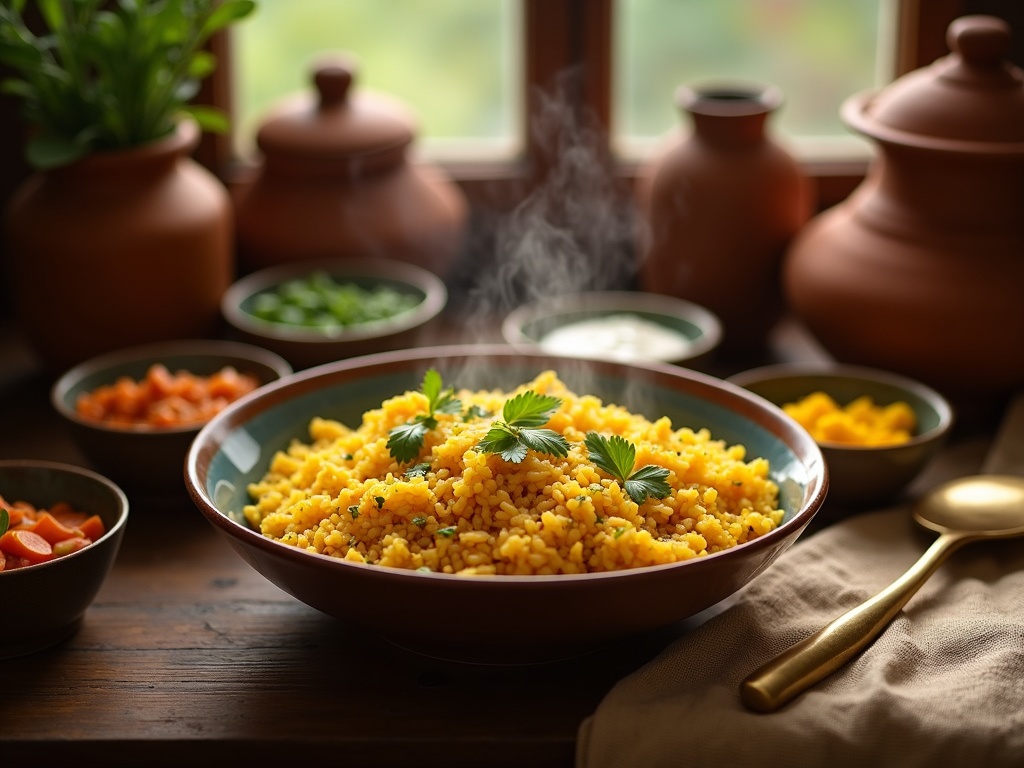
Essential Ingredients You’ll Need
Making khichdi at home requires just a handful of simple ingredients. I’ve found that focusing on quality components elevates this humble dish to something truly special.
Core Ingredients
Rice serves as the foundation of any good khichdi. I prefer short-grain rice for its ability to become soft and slightly mushy when cooked, creating that perfect comforting texture. Short-grain varieties like sona masuri work wonderfully, though basmati can be substituted for a more distinct grain separation.
Yellow moong dal (split mung beans) provides the protein punch in khichdi. These small yellow split lentils cook quickly and blend beautifully with rice. The combination creates a complete protein profile, making khichdi nutritionally balanced.
Ghee (clarified butter) adds depth and richness that’s hard to replace. Just a tablespoon or two transforms it from basic to luxurious. The nutty aroma of ghee toasting whole spices is the signature starting point for an authentic Indian one-pot dish like khichdi.
Basic Indian spices keep it simple yet flavorful. You’ll need:
- Whole cumin seeds for tempering
- Ground turmeric for color and health benefits
- Optional additions: dried red chilies, asafoetida (hing), or bay leaves
Customization Options
Mixed vegetables aren’t traditional in all khichdi variations, but they add nutritional value and texture. Carrots, peas, potatoes, and beans work especially well. I find that adding vegetables makes it a more complete meal, similar to how vegetables enhance a traditional curry dish.
Salt is crucial for enhancing all the flavors. I recommend adding it in stages – some while sautéing vegetables and the rest when adding water.
Water quantity determines your khichdi’s final consistency:
- For a porridge-like texture perfect for upset stomachs, use a 4:1 water to rice-dal ratio.
- For a firmer texture similar to restaurant-style rice dishes, stick to 3:1.
Regional variations might call for additional ingredients like ginger-garlic paste for Gujarati khichdi or coconut milk for South Indian versions. The beauty of this recipe lies in its adaptability – you can make it as simple or elaborate as you like while keeping these essential building blocks in place.
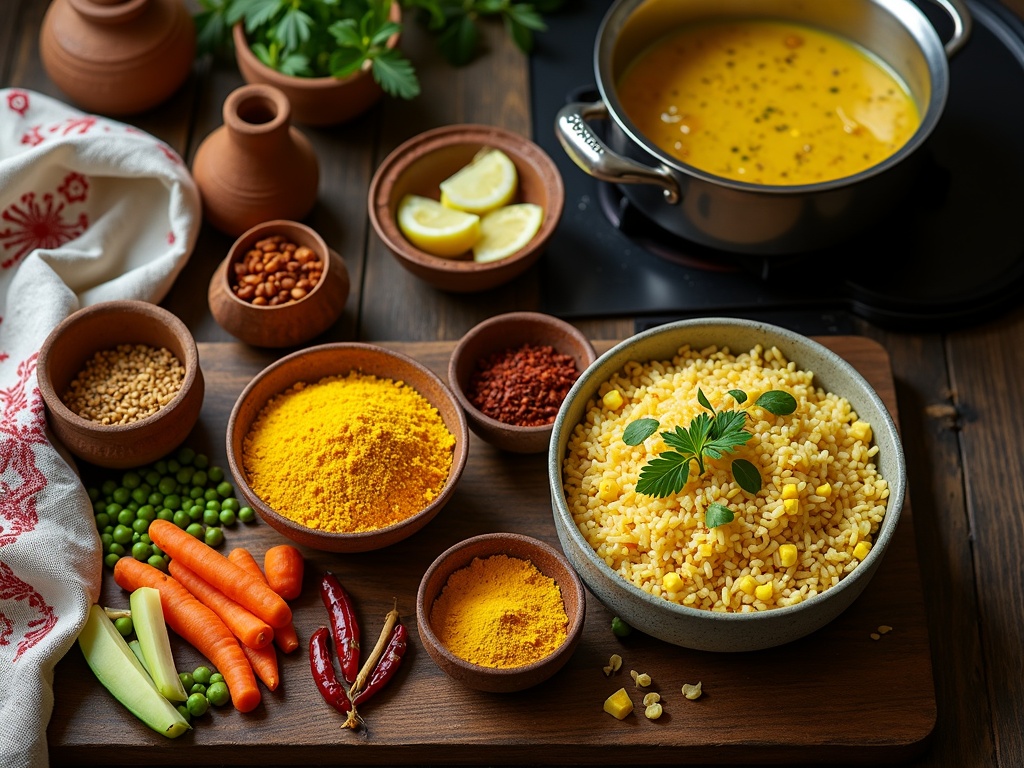
How To Make Perfect Khichdi
Khichdi is the ultimate comfort food in Indian cuisine, and making it perfectly requires just a few simple steps. I’ve perfected this recipe over time, and want to share my process for creating this nourishing one-pot meal that’s both simple and satisfying.
Preparation Steps
Start by thoroughly rinsing both your rice and dal (lentils) under cold water until the water runs clear. This removes excess starch and any impurities. Then soak them together for about 30 minutes – this helps them cook evenly and creates that perfect, soft texture that khichdi pairs wonderfully with chapati.
While the grains are soaking, prepare your vegetables if you’re adding them. Carrots, peas, and potatoes make excellent additions and boost the nutritional value.
- Chop vegetables into small, uniform pieces so they cook evenly.
- Use fresh or frozen vegetables based on availability.
The Cooking Process
Heat a generous tablespoon of ghee in a pressure cooker or heavy-bottomed pot. Once hot, add cumin seeds and let them sizzle until fragrant – usually about 30 seconds. This creates a wonderful aromatic base that’s essential for authentic Indian flavor similar to what you might find in other classics.
- If you’re including vegetables, add them next and sauté for 2–3 minutes.
- Drain the soaked rice and dal mixture and add to the pot, stirring gently to coat with ghee.
- Add your spices:
- Turmeric for color
- Asafoetida for digestibility
- Salt for flavor
- Pour in water at a ratio of 3:1 (water to rice-dal mixture) for a softer consistency.
If using a pressure cooker, cook for about 3–4 whistles. In a regular pot, simmer covered for about 20–25 minutes until everything is soft and mushy.
The final consistency should be adjusted based on personal preference. For a thicker recipe, use less water. For a more porridge-like texture, add more hot water at the end and stir well. A final drizzle of ghee and a squeeze of lemon juice makes this simple dish genuinely special, like the finishing touch on any great recipe.
The beauty of khichdi is its adaptability – you can make it plain for upset stomachs or dress it up with spices and vegetables for a hearty meal. Mastering this basic technique gives you a foundation for countless variations on this classic comfort food.
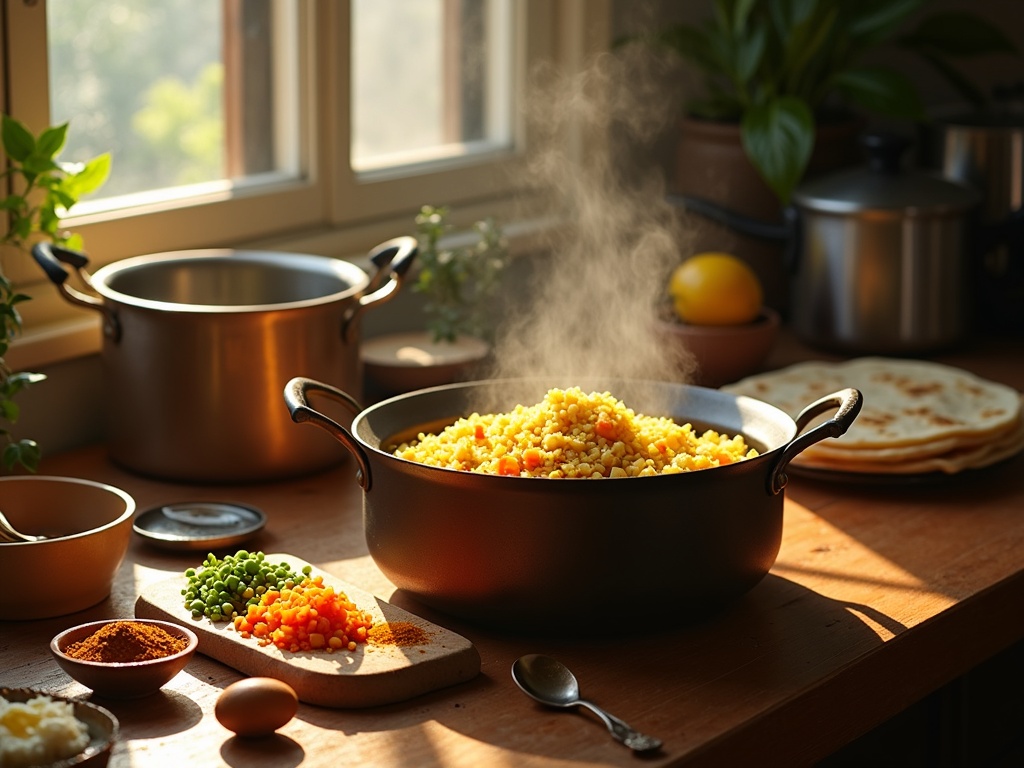
Common Mistakes To Watch For
When preparing khichdi, a few missteps can make the difference between a comforting, perfectly balanced dish and an unsatisfying meal. I’ve encountered these issues myself and learned how to avoid them through years of cooking this classic Indian comfort food.
Key Errors in Khichdi Preparation
Getting the rice-to-dal ratio wrong is perhaps the most common mistake. The ideal proportion is typically 1:1 for moong dal and rice, though some regional variations might adjust this slightly. When I first started cooking it, I’d often add too much rice, resulting in a dish that lacked the proper creamy consistency. If you’re experimenting with different types of lentils like split yellow lentils for khichdi, you might need to adjust this ratio accordingly.
Skipping the tempering process (tadka) drastically reduces the flavor profile of your recipe. This crucial step involves heating ghee or oil and adding spices like cumin seeds, dried red chilies, and asafoetida to release their aromatic compounds. The tempered spices then infuse the entire dish with their flavors. When I’m in a hurry, I’m tempted to skip this step, but the difference in taste is immediately noticeable.
The consistency of khichdi is another make-or-break factor. Making it too dry defeats the purpose of this easily digestible dish, while an overly watery khichdi lacks substance and flavor concentration. Different regions prefer different consistencies—some like it porridge-like while others prefer a more distinct grain texture. Finding your preferred consistency might take practice, but aiming for a texture where the grains are visible yet soft and slightly blended together is a good starting point. Creamy texture in khichdi, similar to other comfort foods, provides that satisfying mouthfeel.
Not soaking ingredients beforehand can lead to uneven cooking and digestive discomfort. I always soak rice and dal for at least 30 minutes before cooking. This practice not only reduces cooking time but also makes the nutrients more bioavailable and the final dish easier to digest—a particularly important benefit when making it for someone who’s feeling unwell.
Using too many spices can overwhelm the inherently simple nature of khichdi. While it’s tempting to add everything from your spice collection for traditional dishes, authentic khichdi relies on a modest selection of spices.
- Cumin seeds
- Turmeric
- Asafoetida
- Bay leaves (optional)
The beauty of khichdi lies in its simplicity and the natural flavors of the ingredients. I typically limit my spices to just a few essentials for a well-balanced dish.
Another subtle mistake is stirring the khichdi too frequently during cooking, which can break the grains and create a mushy texture. Instead, I give it an occasional gentle stir, just enough to prevent sticking at the bottom.
Seasoning is also crucial—under-salting leaves the dish bland, while over-salting can make it inedible. I add salt in stages, tasting as I go to achieve the perfect balance. Remember that the salt level in Indian dishes should complement rather than overpower the other flavors.
For those new to cooking khichdi, these mistakes might seem minor, but addressing them can transform your dish from ordinary to exceptional. With practice and attention to these details, you’ll soon be creating the perfect bowl of khichdi—comforting, nourishing, and delicious.
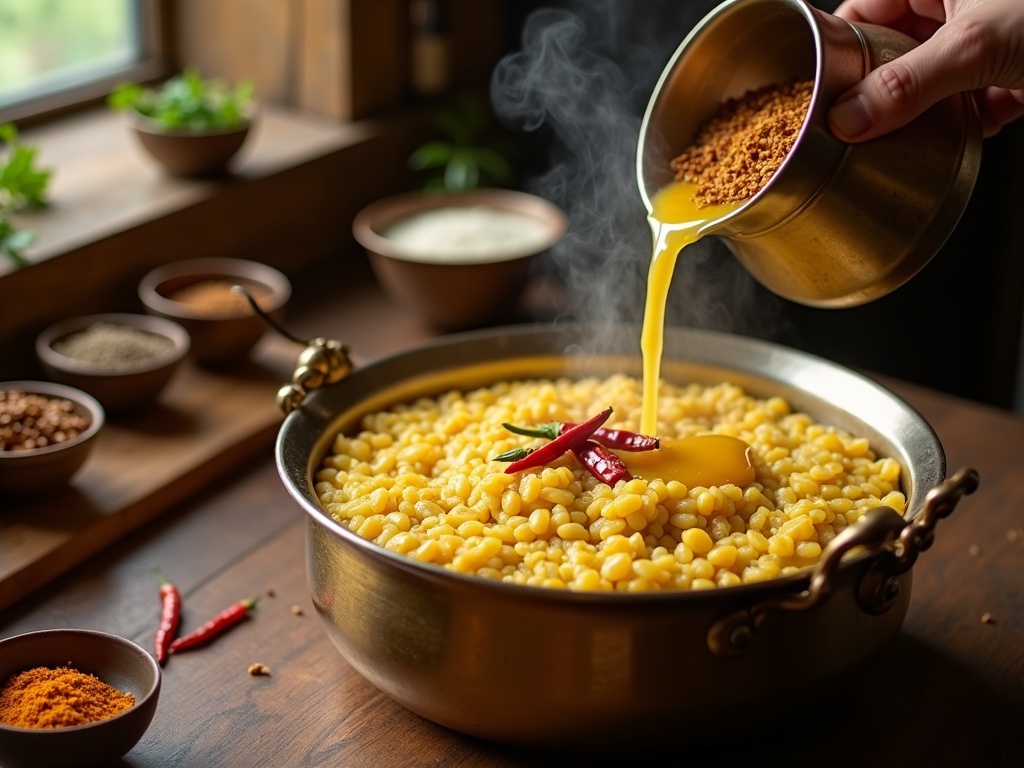
Smart Tips For Better Khichdi
Khichdi, a comforting one-pot meal, can be elevated from a simple dish to something extraordinary with a few clever techniques. I’ve developed these tips through years of perfecting this humble yet versatile dish. These simple adjustments can transform your everyday khichdi into a memorable meal.
Preparation Techniques
Soaking ingredients before cooking is a game-changer for khichdi. I soak rice and lentils for at least 30 minutes (though an hour is ideal) before cooking. This simple step cuts down cooking time significantly and helps the grains cook more evenly. The soaking process also makes nutrients more available and can improve digestion—particularly beneficial for those with sensitive stomachs.
Ghee is non-negotiable for authentic khichdi flavor. Adding a generous spoonful at the beginning when tempering spices and another just before serving creates a rich, nutty flavor that’s impossible to achieve with regular oil. I find that using homemade ghee takes the authentic flavor profile to another level, imparting that traditional taste that makes khichdi so comforting.
The consistency of khichdi can make or break the dish. Some prefer a porridge-like texture while others like a drier version where grains remain separate. I adjust the water ratio depending on the occasion:
- For a healing, easily digestible meal: use a 4:1 water to rice-lentil ratio
- For a heartier meal: stick to a 2:1 ratio
- For a drier pulao-style khichdi: try a 1.5:1 ratio
Don’t forget ginger—it’s not just for flavor but also aids digestion. I add a tablespoon of freshly grated ginger to every pot of khichdi. This warming spice not only enhances the taste but also makes the dish easier on the stomach, aligning perfectly with khichdi’s reputation as a healing food.
Serving Suggestions
Khichdi should always be served hot, as it tends to thicken as it cools. If you’re reheating leftover khichdi, add a splash of water to loosen the consistency before warming it through.
The accompaniments can transform a simple khichdi into a feast. I like to serve mine with:
- A dollop of cooling yogurt or raita
- Spicy pickle for a flavor contrast
- Crispy papadums for textural balance
- A side of roasted vegetables for added nutrition
- A drizzle of lemon juice for brightness
For a complete meal experience, pair your khichdi with soft, freshly made chapatis which complement the dish beautifully.
If you’re making khichdi for someone recovering from illness, keep the spices minimal—just cumin, asafoetida, and a touch of turmeric. For a family dinner, you can be more generous with the spice blend, adding coriander, dried red chilies, and perhaps some garam masala near the end.
Lastly, don’t shy away from adding seasonal vegetables to your khichdi. Beyond the traditional peas and potatoes, try adding cauliflower, carrots, or spinach. This transforms your khichdi into a complete one-pot meal packed with nutrients. I often prepare a vibrant vegetable khichdi when I want something satisfying yet light, similar to how fresh flavors enhance popular street food dishes.
With these simple adjustments, your khichdi will go from basic to brilliant—proving that sometimes the most straightforward dishes can be the most satisfying when prepared with care.
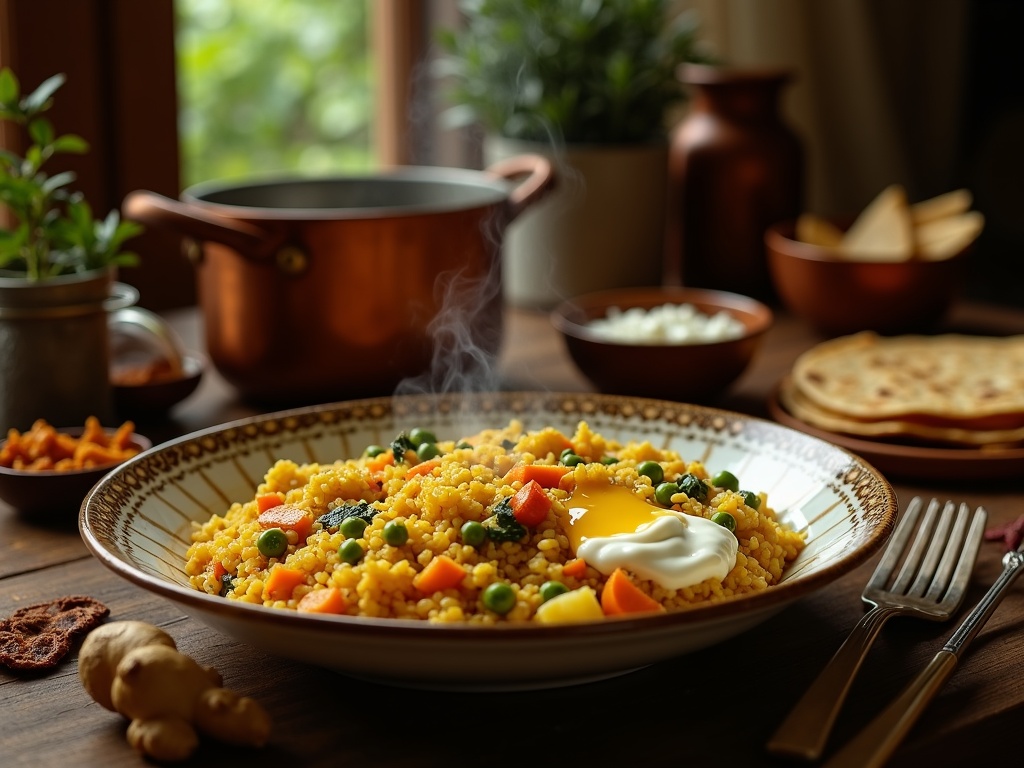
Serving Suggestions
Khichdi shines brightest when paired with complementary sides and toppings that enhance its comforting qualities. I’ve found that the right accompaniments can transform this humble dish into a complete meal experience. Let me share some tried and tested serving suggestions that will elevate your khichdi from simple to spectacular.
Traditional Accompaniments
A dollop of yogurt or raita creates the perfect temperature and flavor balance with khichdi. The coolness of yogurt cuts through the warmth of the spiced rice and lentils, while adding a creamy texture that complements the dish perfectly. For something more flavorful, a cucumber raita with a hint of roasted cumin makes an excellent pairing.
Papadums make an essential crispy side that adds textural contrast to soft khichdi. I like to roast them directly over a flame or in the microwave rather than frying for a healthier option. The crackling texture of papadums against the soft, porridge-like consistency of traditional Indian khichdi creates a satisfying eating experience.
No serving of khichdi is complete without a generous drizzle of ghee on top. This final touch adds richness and brings out all the aromatic spices in the dish. For special occasions, I sometimes infuse the ghee with cumin or asafoetida before drizzling it over the hot khichdi.
Garnishes and Condiments
Fresh coriander leaves scattered on top add color and a burst of freshness to your khichdi. The herbaceous notes cut through the richness and add a visual appeal that makes the dish more inviting. For extra flavor, you could mix in some finely chopped green chilies with the coriander for those who enjoy heat.
Pickles and chutneys are essential sidekicks to khichdi that add complexity and punch. A spoonful of mango pickle provides tangy heat, while mint chutney offers cooling herbaceousness. I often serve homemade condiments alongside khichdi to let everyone customize their bowl according to taste preferences.
Here are some additional serving ideas that can turn your khichdi into a feast:
- Serve with a side of roasted vegetables seasoned with cumin and red chili powder
- Add a protein boost with a hard-boiled egg or grilled chicken on the side
- Include a small bowl of seasoned buttermilk or chaas as a refreshing beverage
- Top with crispy fried onions for added texture and flavor
- Serve with a side of spiced potato curry for a more substantial meal
Khichdi’s versatility makes it the perfect canvas for various serving styles. For a more indulgent presentation, I sometimes create a rich topping of caramelized onions and cashews to sprinkle over the top.
For gatherings, consider setting up a khichdi bar with various toppings and sides. This interactive approach allows guests to customize their bowls and creates a fun dining experience centered around this beloved comfort food.
On cold evenings, serving khichdi in pre-warmed bowls helps maintain its perfect temperature throughout the meal. I find that earthenware or clay bowls not only keep the khichdi warm longer but also add a rustic charm to the presentation.
When serving khichdi as part of a larger spread, it pairs beautifully with sweet treats for dessert, creating a balanced meal that satisfies all taste buds. The simple, savory nature of khichdi makes it an ideal counterpoint to sweeter dishes that follow.
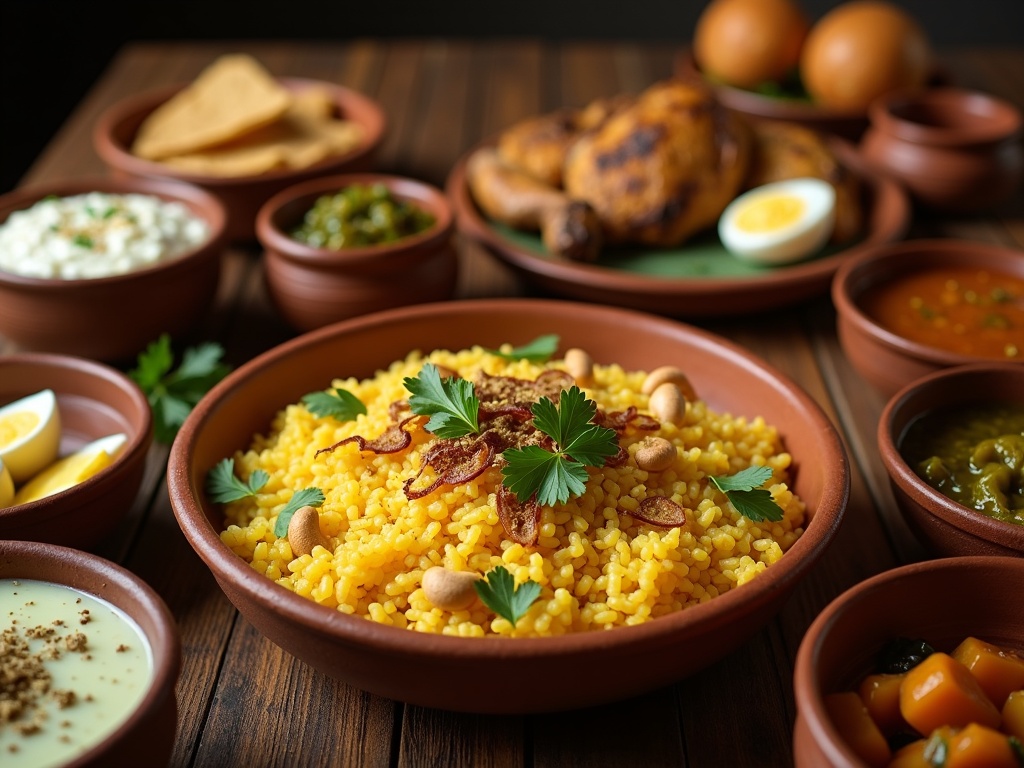
Health Benefits And Uses
Khichdi stands as one of the most nutritious and versatile dishes in Indian cuisine. Its simplicity belies its power as a health food that serves multiple purposes across different life stages and health conditions.
Nutritional Support During Illness and Recovery
When I’m feeling under the weather, khichdi becomes my go-to meal. Its soft texture and simple preparation make it incredibly easy to digest, perfect for when the digestive system needs gentle support. The combination of rice and lentils breaks down effortlessly in the stomach, requiring minimal digestive effort while still providing essential nutrients needed for recovery.
During illness recovery, the body needs nutritional support without additional strain. Khichdi serves as the ideal comfort food that doesn’t overwhelm the system. I’ve found that adding a touch of ghee (clarified butter) enhances both the flavor and the medicinal properties, as Ayurvedic tradition suggests that ghee aids in carrying nutrients deeper into body tissues.
For those recovering from stomach ailments or surgery, khichdi offers these key benefits:
- Low irritant profile with minimal spices when needed
- Soft texture requiring little chewing effort
- Balanced nutrition in an easily absorbed form
- Customizable ingredients based on specific health needs
- Hydrating properties when prepared with adequate water
Khichdi also serves as an excellent first solid food for babies transitioning from milk. Its mushy consistency poses minimal choking hazards, and I can easily adjust the texture from very soft to slightly more textured as the baby grows. The gentle spices can be completely omitted initially and gradually introduced to familiarize infants with flavors.
Beyond digestive comfort, khichdi provides a balanced protein source through its combination of rice and lentils. This pairing creates a complete protein profile containing all essential amino acids. Unlike heavy meat proteins that can be difficult to process during illness, khichdi’s vegetarian protein alternative offers a gentler option that doesn’t compromise on nutritional value.
For weight management, khichdi presents a smart choice. I can control the calorie content by adjusting the ghee quantity while maintaining satiety through the fiber-rich lentils. Adding vegetables increases the volume and nutritional density without significantly increasing calories, making it perfect for portion-controlled eating plans.
The versatility extends to addressing specific health concerns:
- For diabetics, switching to brown rice or millets in the khichdi reduces the glycemic impact.
- For those with heart concerns, I might prepare it with minimal oil and additional heart-healthy spices like turmeric.
- When fighting inflammation, adding ginger and turmeric transforms the dish into functional food with anti-inflammatory properties.
Many fitness enthusiasts turn to khichdi as a post-workout meal because it delivers complex carbohydrates for glycogen replenishment alongside protein for muscle recovery. The balanced nutrition in khichdi makes it superior to many processed recovery foods.
Traditional Ayurvedic medicine has long recognized khichdi’s healing properties. Different combinations of spices and ingredients create specific medicinal variations targeted to balance different body constitutions. The dish features prominently in panchakarma, the Ayurvedic detoxification process, where its simple composition helps the body reset and heal.
Khichdi truly represents food as medicine – nourishing, healing, and adaptable to countless health needs across all life stages.
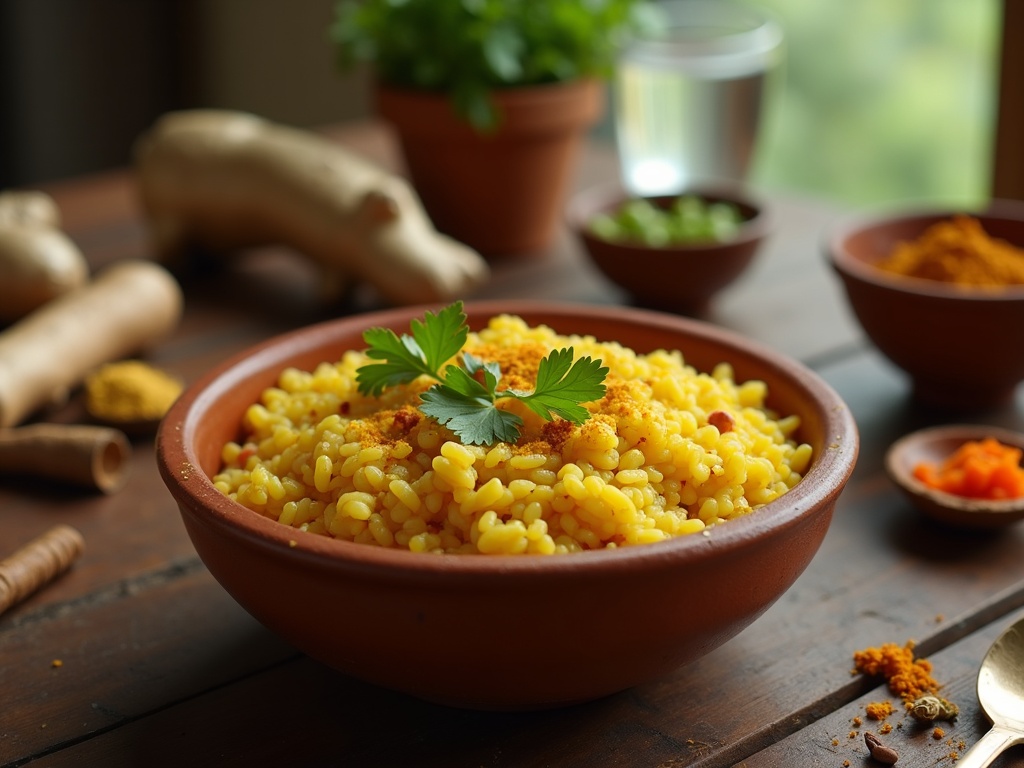
Regional Variations Worth Trying
The humble khichdi transforms across India’s diverse regions, each version carrying distinct flavors and cooking methods. I’ve sampled countless varieties during my culinary journeys and can attest that these regional variations offer unique taste experiences.
Northern and Eastern Delights
Bengali bhoger khichuri stands out as a festive favorite, typically prepared during Durga Puja celebrations. Unlike its simpler counterparts, this version incorporates vegetables like cauliflower, potatoes, and peas, along with aromatic ghee and garam masala. The distinctive yellow color comes from turmeric, while the texture remains slightly moist and comforting.
Bihari khichdi pairs beautifully with mutton or chicken dishes for a complete meal. It tends to be drier than other versions and often features generous amounts of ghee with a special chokha (mashed vegetable) accompaniment that adds tang and depth.
Moving westward, Gujarati kadhi khichdi creates a perfect flavor marriage. The khichdi itself remains subtle with minimal spicing, while the accompanying sweet-tangy kadhi (yogurt-based curry) provides contrasting flavors. Many Gujarati households serve this with a side of warm chapatis for a wholesome dinner.
The Maharashtrian masala khichdi packs more heat and spice than its counterparts. It incorporates dry-roasted spices, onions, and sometimes tomatoes for a more robust flavor profile. This version often gets paired with papad and pickle for textural contrast.
In South India, pongal represents the Tamil version of khichdi, made during the harvest festival of the same name. The savory variety (ven pongal) combines rice and moong dal with black pepper, cumin, and plenty of ghee. For those with a sweet tooth, sweet pongal made with jaggery offers a delicious dessert alternative.
Each regional variation reflects local ingredients, cooking traditions, and flavor preferences. Some feature vegetables prominently, while others focus on the perfect rice-lentil ratio. Some versions appear at religious ceremonies, while others make regular appearances on family dinner tables.
What makes these regional variations special isn’t just their flavor profiles but the cultural significance attached to them. From healing sick family members to celebrating festivals, each khichdi variety carries stories and traditions worth experiencing firsthand.
